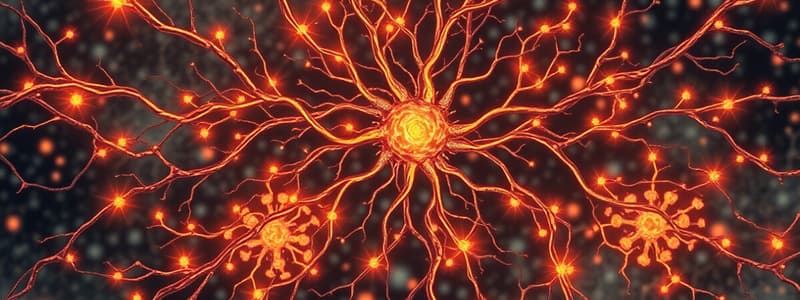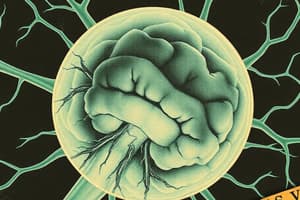Podcast
Questions and Answers
What term describes a nerve impulse running towards the brain and CNS?
What term describes a nerve impulse running towards the brain and CNS?
- Motor
- Afferent (correct)
- Sensory
- Efferent
Which type of nerve fibers conduct impulses more quickly?
Which type of nerve fibers conduct impulses more quickly?
- Unmyelinated fibers
- Sensory fibers
- Myelinated fibers (correct)
- Afferent fibers
What is the primary mechanism for the generation of an action potential?
What is the primary mechanism for the generation of an action potential?
- Movement of ions across the nerve cell membrane (correct)
- Myelination of axons
- Cellular metabolism increase
- Stimulated sensory organ activation
What is the resting membrane potential primarily due to?
What is the resting membrane potential primarily due to?
How do nerve impulses travel within an axon?
How do nerve impulses travel within an axon?
What is the primary role of the Nodes of Ranvier in nerve conduction?
What is the primary role of the Nodes of Ranvier in nerve conduction?
Which of the following statements about nerve impulses is correct?
Which of the following statements about nerve impulses is correct?
What initiates a nerve impulse?
What initiates a nerve impulse?
Which of the following correctly describes the nature of action potentials?
Which of the following correctly describes the nature of action potentials?
What best describes the significance of myelination in nerve conduction?
What best describes the significance of myelination in nerve conduction?
What is the main function of the sodium/potassium pump during neuronal activity?
What is the main function of the sodium/potassium pump during neuronal activity?
What triggers the opening of voltage-gated sodium channels in a neurone?
What triggers the opening of voltage-gated sodium channels in a neurone?
During the repolarization phase of the action potential, which ion channels are primarily responsible for returning the membrane potential to a negative value?
During the repolarization phase of the action potential, which ion channels are primarily responsible for returning the membrane potential to a negative value?
What occurs at the synapse during synaptic transmission?
What occurs at the synapse during synaptic transmission?
Which statement about the action potential is true?
Which statement about the action potential is true?
What characterizes the period during which the neurone cannot be re-stimulated?
What characterizes the period during which the neurone cannot be re-stimulated?
What is exocytosis in the context of synaptic transmission?
What is exocytosis in the context of synaptic transmission?
What happens when the membrane potential becomes more positive during an action potential?
What happens when the membrane potential becomes more positive during an action potential?
Which ions are primarily involved in establishing the resting membrane potential of a neurone?
Which ions are primarily involved in establishing the resting membrane potential of a neurone?
What process describes the release of neurotransmitters from the synaptic vesicles?
What process describes the release of neurotransmitters from the synaptic vesicles?
Which neurotransmitter is NOT mentioned as being present in the brain and spinal cord?
Which neurotransmitter is NOT mentioned as being present in the brain and spinal cord?
What effect do local anaesthetics have on sodium channels in nerve cells?
What effect do local anaesthetics have on sodium channels in nerve cells?
What is one of the effects of increased membrane threshold for excitation caused by anaesthetics?
What is one of the effects of increased membrane threshold for excitation caused by anaesthetics?
Which condition is a result of excessive nerve impulses?
Which condition is a result of excessive nerve impulses?
How do neurotransmitters achieve their action on post-synaptic membranes?
How do neurotransmitters achieve their action on post-synaptic membranes?
What modifies neuronal excitability according to the content?
What modifies neuronal excitability according to the content?
What happens to neurotransmitter action after it has occurred?
What happens to neurotransmitter action after it has occurred?
What occurs during the transport of neurotransmitters along axons?
What occurs during the transport of neurotransmitters along axons?
Which of the following statements about the journey of a neurotransmitter is true?
Which of the following statements about the journey of a neurotransmitter is true?
Flashcards
Efferent (motor) nerve impulse
Efferent (motor) nerve impulse
Nerve impulses that travel from the brain to other parts of the body, carrying instructions for movement, actions, and other functions.
Afferent (sensory) nerve impulse
Afferent (sensory) nerve impulse
Nerve impulses that travel from sensory receptors to the brain, carrying information about the environment and the body.
Action potential
Action potential
A single signal that travels along a nerve fiber, causing depolarization of the membrane.
Synaptic Transmission
Synaptic Transmission
Signup and view all the flashcards
Nodes of Ranvier
Nodes of Ranvier
Signup and view all the flashcards
Myelinated fibers
Myelinated fibers
Signup and view all the flashcards
Resting membrane potential
Resting membrane potential
Signup and view all the flashcards
Voltage-gated ion channels
Voltage-gated ion channels
Signup and view all the flashcards
Depolarization
Depolarization
Signup and view all the flashcards
Repolarization
Repolarization
Signup and view all the flashcards
Sodium-potassium pump
Sodium-potassium pump
Signup and view all the flashcards
Synapse
Synapse
Signup and view all the flashcards
Neurotransmitters
Neurotransmitters
Signup and view all the flashcards
Synaptic vesicles
Synaptic vesicles
Signup and view all the flashcards
Exocytosis
Exocytosis
Signup and view all the flashcards
Neurotransmitter receptor
Neurotransmitter receptor
Signup and view all the flashcards
Serotonin
Serotonin
Signup and view all the flashcards
Noradrenaline
Noradrenaline
Signup and view all the flashcards
Dopamine
Dopamine
Signup and view all the flashcards
Acetylcholine
Acetylcholine
Signup and view all the flashcards
Histamine
Histamine
Signup and view all the flashcards
Anaesthetics
Anaesthetics
Signup and view all the flashcards
Local anaesthetics
Local anaesthetics
Signup and view all the flashcards
Neuralgia
Neuralgia
Signup and view all the flashcards
Trigeminal neuralgia
Trigeminal neuralgia
Signup and view all the flashcards
Adrenaline
Adrenaline
Signup and view all the flashcards
Neuronal excitability
Neuronal excitability
Signup and view all the flashcards
Melatonin
Melatonin
Signup and view all the flashcards
Study Notes
Neurotransmission
- Nerve impulses are initiated by sensory nerve endings or by the passage of an impulse from another nerve.
- An impulse to the brain is known as Afferent (sensory).
- An impulse from the brain is known as Efferent (motor).
- Nerve impulses (action potential):
- Travel in one direction.
- Can only send one message at a time but the frequency can vary depending on the situation.
- Nerve impulses travel in one direction - from the cell body down the axon to the dendrite.
- Some axons transmit action potential faster:
- Myelinated fibres conduct much more quickly.
- Action potential jumps along gaps between cells, called NODES OF RANVIER.
- The transmission of action potential is carried out by the movement of ions across the nerve cell membrane.
- Resting/unstimulated state:
- The nerve cell membrane is polarized from ion differences across the plasma membrane.
- Different electrical charge on either side of the membrane - resting membrane potential.
- At rest, the outside is positive (+) and the inside is negative (-).
- Main ions: sodium and potassium.
- Ion channels in the axon are voltage gated.
- If the stimulus is strong enough, the voltage-gated sodium channels open.
- The membrane depolarizes, and the membrane potential becomes more positive.
- Depolarization at one segment triggers the opening of other ion channels in the next segment.
- The action potential spreads along the axon in a wave of depolarization.
- After depolarization, the segment repolarizes as the slower voltage-gated potassium channels open.
- Potassium ions flow out, making the membrane less positive and more negative.
- Returning to the resting state.
- Cannot be re-stimulated while repolarizing, the closed potassium channels will not respond.
- Sodium-potassium pump:
- Actively transports sodium ions back out and potassium ions back in.
- Restores the original ion distribution.
- Restores the electrolyte chemical gradient at the resting level.
- The gated channels open and close to allow the movement of ions and transmission of impulses.
Synaptic Transmission
- Nerves are not joined together or connected.
- Most information is passed chemically.
- The point at which a nerve impulse jumps from one nerve to another is known as a synapse.
- There are approximately 1,000 trillion synapses in the brain.
- When the action potential reaches the presynaptic nerve terminal, neurotransmitters are released from synaptic vesicles in the synaptic knob of the axon.
- They diffuse into the synaptic cleft and attach to neuro-receptors on the synaptic knob of the dendrite of another nerve.
- Synaptic knobs contain spherical, membrane-bound synaptic vesicles that store neurotransmitters.
- Neurotransmitters are chemicals released into the synaptic cleft.
- Exocytosis moves materials from the interior of the cell to the exterior.
- It requires energy and is a form of active transport.
- The journey of a neurotransmitter:
- Synthesized by nerve cell bodies.
- Actively transported along the axons.
- Stored in the synaptic vesicles.
- Released by exocytosis in response to the action potential.
- Diffuse across the synaptic cleft.
- Act on specific receptor sites on the postsynaptic membrane.
- Action is short lived.
- After action, inactivated by enzymes or taken back into the synaptic knob.
- There are over 50 known transmitters in the brain and spinal cord:
- Noradrenaline.
- Adrenaline.
- Dopamine.
- Histamine.
- Serotonin.
- Acetylcholine.
- Neurotransmitter function is modified by extrinsic and intrinsic factors:
- Changes in pH can alter neuronal excitability.
- They are dependent on an adequate oxygen supply.
- Many drugs increase neuronal excitability or inhibit the action of neurotransmitters.
- Anaesthetics increase the membrane threshold for excitation and decrease synaptic transmission at many points in the nervous system.
- Local anaesthetics block the nerve transmission to pain centres in the central nervous system.
- Local anaesthetics block the movement of nerve impulses near the site of injection by binding to and inhibiting the function of ion channels (sodium channels) in the nerve cell membrane.
- Excessive nerve impulses can result in neuralgia:
- Most commonly, trigeminal neuralgia.
Teeth and Nerve Impulses
- Teeth are highly innervated by myelinated and non-myelinated fibres.
- Teeth are highly susceptible to tactile, thermal, or painful stimuli.
- Local anaesthetics cause a reversible block in nerve transmission to pain centres in the central nervous system.
- Local anaesthetics block sodium channels which prevents action potentials.
Studying That Suits You
Use AI to generate personalized quizzes and flashcards to suit your learning preferences.




